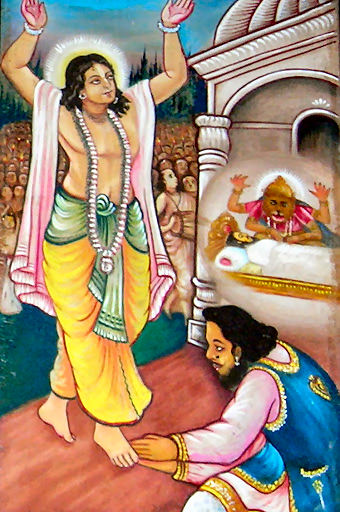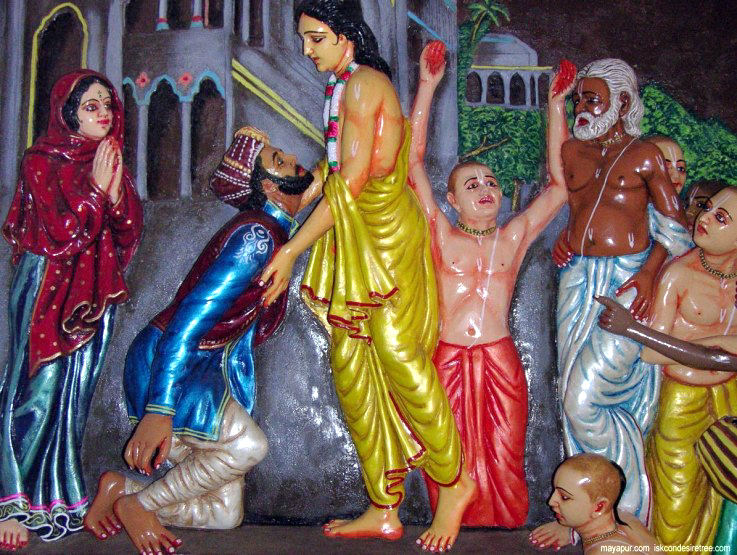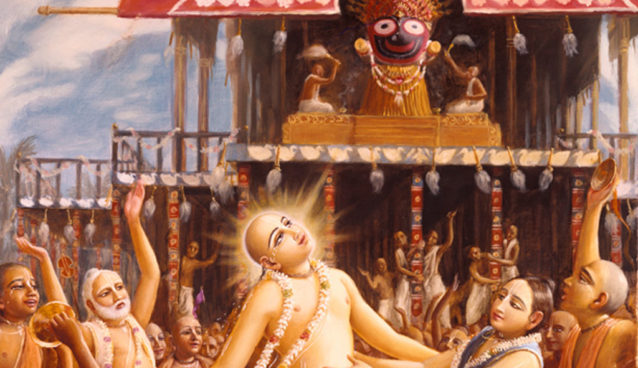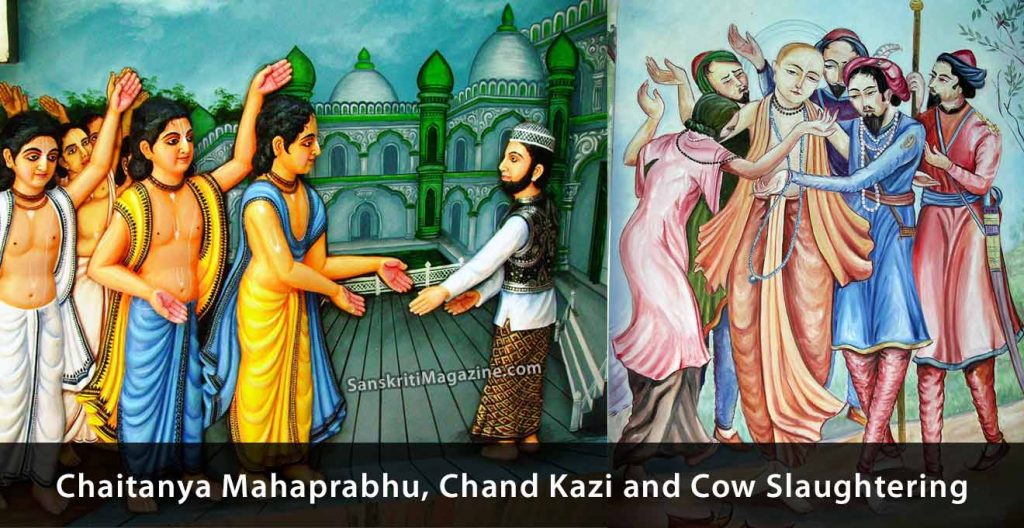Lord Chaitanya Mahaprabhu appeared in the late fifteenth century, 1486. He took birth in Bengal, India, which at the time was being governed by the Pathana Muslims. At the age of seventeen Chaitanya Mahaprabhu started his sankirtana movement (the congregational chanting of God’s names). He preached to all the citizens of Navadvipa to chant the Hare Krishna mantra (hymn), and in each and every home they began performing sankirtana regularly.
Hearing the continuous chanting of the Hare Krishna mantra, the local Muslims became very disturbed and submitted a formal complaint to the Chand Kazi. The Navadvipa city magistrate holds the title of Kazi. The city magistrate at that time was known as Chand Kazi. It is said that Chand Kazi was the spiritual master of Nawab Hussein Shah.
 At that time to convert a Hindu into a Muslim was an easy affair in those days. If a Muslim simply sprinkled water on the body of a Hindu, it was supposed that the Hindu had become a Muslim. Hindu society was so strict at the time of Chaitanya that if a Hindu was converted into a Muslim, there was no chance of him being readmitted into the Hindu religion. In this way the Muslim population in India increased. None of the Muslims came from outside; social customs somehow or other forced Hindus to become Muslims, with no chance of returning to Hindu society. Emperor Auranzeb also inaugurated a tax, which only Hindus had to pay. Thus all the poor Hindus of the lower class voluntarily became Muslims to avoid the fax. In this way the Muslim population in India increased. Chand Kazi threatened to convert the people into Muslims by the simple process of sprinkling water on their bodies.
At that time to convert a Hindu into a Muslim was an easy affair in those days. If a Muslim simply sprinkled water on the body of a Hindu, it was supposed that the Hindu had become a Muslim. Hindu society was so strict at the time of Chaitanya that if a Hindu was converted into a Muslim, there was no chance of him being readmitted into the Hindu religion. In this way the Muslim population in India increased. None of the Muslims came from outside; social customs somehow or other forced Hindus to become Muslims, with no chance of returning to Hindu society. Emperor Auranzeb also inaugurated a tax, which only Hindus had to pay. Thus all the poor Hindus of the lower class voluntarily became Muslims to avoid the fax. In this way the Muslim population in India increased. Chand Kazi threatened to convert the people into Muslims by the simple process of sprinkling water on their bodies.
Lord Shri Krishna Chaitanya Mahaprabhu’s sankirtan-lila was never revealed in any previous incarnation. Lord Chaitanya looked as effulgent as a million suns. Fragrant malati flowers decorate His hair, and a beautiful floral garland of five varieties of flowers hung down to His knees. His body shone like molten gold and was smeared with sandalwood paste. A sweet smile adorned His face. Lord Chaitanya, with Prabhu Nityananda close by His side, began leading hundreds of thousands of people north along the bank of the Ganges river. First He went to His own bathing place called Mahaprabhu Ghat and danced ecstatically. After that, He danced to Madhai Ghat, Barakona Ghat, and Nagariya Ghat and then left the bank of the Ganges. Lord Chaitanya then danced through the village of Ganganagar and then on to Simulia where the Chand Kazi resided. This can be read verbatim in the Shri Chaitanya Bhagavata, Madhya Khanda, Chapter 23 (beginning with verse 298) by Shrila Vrindavana das Thakur.
When the Kazi heard the tumultuous uproar, he sent his spies to discover the cause of the commotion. When the spies saw the huge nagar sankirtan party which stretched for miles, and when they heard the roaring Hare Krishna kirtan, they immediately fled in terror. They reached the Kazi and advised him to flee. They then reported what they had seen.
 The Kazi began to shake in fear as the sankirtan party got close. The kirtan became louder and louder. Suddenly, it was outside his door, and above the powerful resounding of Hari Nama, a voice like thunder said, “Where is that mischief monger Chand Kazi who tried to stop My sankirtan movement? I have incarnated to propagate the congregational chanting of the Holy Names of Lord Krishna. I am always present wherever My devotes ecstatically chant My Holy Names! How dare he break the mridanga that accompanies My sankirtan? How dare he obstruct what I have inaugurated to redeem this world? Now break down the doors and bring that rascal to Me without delay. Destroy anyone that stands in your way!” The Lord’s words sounded like the roaring of a lion.
The Kazi began to shake in fear as the sankirtan party got close. The kirtan became louder and louder. Suddenly, it was outside his door, and above the powerful resounding of Hari Nama, a voice like thunder said, “Where is that mischief monger Chand Kazi who tried to stop My sankirtan movement? I have incarnated to propagate the congregational chanting of the Holy Names of Lord Krishna. I am always present wherever My devotes ecstatically chant My Holy Names! How dare he break the mridanga that accompanies My sankirtan? How dare he obstruct what I have inaugurated to redeem this world? Now break down the doors and bring that rascal to Me without delay. Destroy anyone that stands in your way!” The Lord’s words sounded like the roaring of a lion.
At that time, some venerable and saintly souls fell at Mahaprabhu’s feet and requested that He become merciful. They said that the Vedas describe the Supreme Lord as always poised, blissful and free from anger. Even when Brahma stole all His cowherd friends and calves, and even when Indra attacked Vraja with excessive rains, still the Lord remained equipoised. They requested the Lord to not in this way abandon His neutrality and minimize the Vedic injunctions. Lord Chaitanya became pleased, and He sent several respectable members of the brahminical community within the house of Chand Kazi. They found him in a corner, petrified, and shaking in fear. After becoming calm, the Kazi came out before the Lord with his head bowed. As the Chand Kazi was His maternal uncle, Kamsa, in Krishna lila, Lord Chaitanya addressed him as uncle.
After exchanging some polite formalities, Lord Chaitanya said to him: go dugdha khao, gabi tomara mata. “You drink cow’s milk, therefore the cow is your mother.” (Shri Chaitanya Charitamrita, Adi-lila, Chapter 17, Verse 153)
Lord Chaitanya then asked the Kazi why he killed and ate cows. The cow is the mother of everybody because the cow unselfishly and indiscriminately gives everyone her own milk. How can one justify killing and eating such a mother?
Although the words of Lord Chaitanya are simple, they are deep. Not even an animal who receives milk from his mother, or the offspring of any mammal, will kill and eat his own mother. Only the human animal will do this! Even in the human species, when a mother’s breast milk has dried up, a mother will immediately accept a cow as surrogate mother and lovingly feed her infant milk from that cow.
Then Lord Chaitanya Mahaprabhu said to him:
go-angayata loma, lata sahasra vatsara
go-vadhi raurava-madhye pace nirantara
“Cow killers and cow eaters are condemned to rot in a hellish condition of life for as many thousands of years as there are hairs on the body of each cow they eat.” (Shri Chaitanya Charitamrita, Adi-lila, Chapter 17, Verse 166)

There are many mistakes and illusions in non-Vedic scriptures. The compilers of these scriptures, not being exposed to the Absolute Truth, could not realize the essence of spiritual knowledge. They thus wrote things directly against logic and reason. Even the most basic of religious concepts, like the nature of the soul, the transmigration of the soul from body to body, and the eternality of the soul, cannot even be directly understood from these scriptures. In addition, the answers in these scriptures to many questions have changed over the centuries and are contradictory to the conclusions of the past. As the philosophy of these religions changes from time to time, this indicates that the original compilations were not of an eternal nature.
Even though Chand Kazi was the spiritual guide of the Emperor Hussein Shah, still his spiritual understanding and philosophy stemming from the Koran was inadequate and deficient. The Muslim Kazi himself concluded: sahaja yavana-sastre adrdha vicara. ‘The reasonings and arguments in the scriptures of meat-eaters is not based on very sound judgement.” (Shri Chaitanya Charitamrita, Adi-lila, Chapter 17, Verse 171)
Chand Kazi stated that according to the Muslim book, the Koran, there is no mention or any authorization for killing the cow. He concluded that those who say these conclusions are authorized are speaking against the Holy Koran. From that time onwards, Chand Kazi became a devotee and he refrained from meat-eating and the killing of any creature. Even during the chaotic Hindu-Muslim riots, the descendants of Chand Kazi kept intact the promise given by their ancestor and never had any conflict with the Hindus.

Lord Chaitanya, changing the subject, asked the Kazi why that night before he had stopped the sankirtan at Shrivas Angan but that today he did not try to stop it. The Kazi, looking grave, told the Lord that after breaking the mridanga he came home and went to bed. That night he dreamed that a ferocious and fearful being with the body of a man and the head of a lion and who possessed frightful teeth and elongated nails threatened him with death if he ever again impeded the sankirtan movement. Sitting on his chest and roaring fearfully, He scratched him. The Kazi then bared his chest, and the devotees saw the unmistakable nail marks of a lion. They immediately remembered Nrsimha-deva and accepted the Kazi’s story in great wonderment.
The Chand Kazi, with tears in his eyes, then fell at the lotus feet of the Lord and vowed that from that day onwards neither he nor anyone from his dynasty would ever, now or in the future, put any obstruction whatsoever to the sankirtan movement. If, said the Kazi, any descendant of his ever did so, then that descendant would be rejected from the family and disinherited. Hearing this, Lord Chaitanya chanted “Hari! Hari!” Rising, He led the jubilant and victorious sankirtan party back to Shridham Mayapur. As He was returning, He stopped at the house of His dear devotee Shridhara.
After Chand Kazi left his body, his samadhi was placed in Navadvipa. This tree towering above his Samadhi is more than 500 years old. This tree actually witnessed all these past events. Devotees of Lord Chaitanya, feeling humility, circumambulate the Chand Kazi’s samadhi for he received the Lord’s mercy. If you look up at the tree you will see that although it is hollow inside, it still always offers nice flowers.










